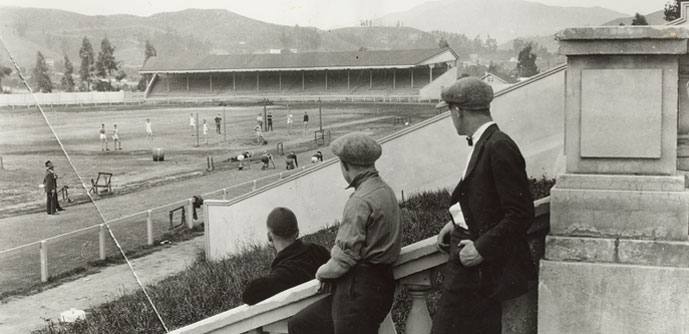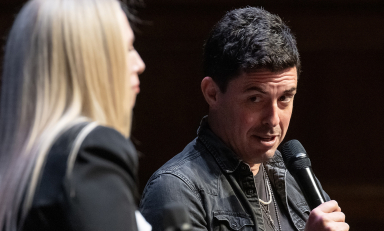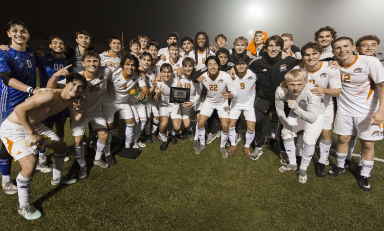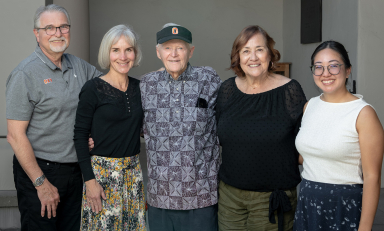
During 125 years of patient accumulation, certain gifts have pointed the College in a particular direction, created a signature program, or left an unmistakable mark on the Occidental we know today. Here are the stories of a dozen milestone donations
By Jim Tranquada
There are two ways to grow a college: Find a single donor with deep pockets, or convince alumni and friends that your institution is worthy of their support. And without a Johns Hopkins, Henry Rutgers, or William Carleton in its history, Oxy has done it the hard way over the last 125 years. "Where could you better invest some money?" President John Willis Baer asked in a 1913 community appeal. "Where could you better place a lasting memorial?"
During this process of patient accumulation, there have been gifts that pointed the College in a particular direction, created a signature program, or otherwise left an unmistakable mark on the Occidental we know today. The corporation and foundation support that contributes around $5 million to the College each year; the Oxy faculty—from Besemer and Boesche to Studenmund and Shearer—who populate a long list of endowed professorships; even the computer technology that quickly became an indispensable part of a college education: Each began with a milestone donation. Here are the stories behind a dozen such gifts.
Neighborhood Swatch
Early into the 20th century, the move from Oxy's second home in Highland Park was inevitable. The 15-acre parcel was too small for the College's growing ambitions, and the campus was divided by a Southern Pacific Railroad track whose noisy freight trains literally brought classes to a halt, as no one could be heard over the din.
Oxy's move to Eagle Rock owes as much to the business of selling real estate as it does to the philanthropy of the donors who gave the College 75 of the first 90 acres of the College's current campus. The syndicate of James G. Garth, William A. Roberts, Ralph Rogers, and Samuel McCray offered the property in 1909, believing that having a college campus adjacent to your subdivision helped move real estate.
"Every lot is within two blocks of the campus," an early ad for Occidental Park pointed out. "The most valuable properties will always be those fronting on and adjoining the campus grounds."
It was the same theory that led three partners in a real estate venture to donate a campus site and hundreds of surrounding lots to USC, the founders of the city of Whittier to donate a 20-acre parcel for "college purposes," and for Oxy's first supporters to give a campus site and surrounding lots in Boyle Heights for Oxy's first campus.
A King-Sized Memorial
A 1903 graduate, the Rev. Horace "King" Cleland was one of the most popular and accomplished students of his generation—a talented athlete, manager of the student newspaper, and president of the campus YMCA. So the Oxy community was shocked when Cleland died of pleurisy in June 1907 at age 25. "His share as a student in making the character of Occidental in her early days, and his influence in the college, cannot be overstated," The Occidental wrote.
Determined to create a suitable memorial to Cleland, the Alumni Association decided that "instead of making individual and scattering subscriptions to support the Alumni Scholarship, the Alumni Association as a whole should undertake to endow a perpetual scholarship."
An ambitious undertaking for a young college with fewer than 100 graduates, it took several years to reach the $1,000 goal. But the association's determined effort created a model that has been repeated more than 330 times since then. Endowed scholarships have made an Occidental education affordable for literally thousands of students over the years.
The First Foundation
When President Remsen Bird announced at Convocation in 1922 that the College had received $166,666 from John Rockefeller's General Education Board for Oxy's endowment—its first foundation grant—the students and faculty assembled in the chapel that day "shook the roof." with their enthusiastic response. If only they had known that it had taken 15 years and five rejections to reach that point.
Foundation philanthropy was in its infancy in 1907 when Occidental President John Willis Baer first approached the 5-year-old General Education Board. Faced with nearly 500 applications, the foundation's board turned down Oxy's application, concluding "that there is such duplication of collegiate equipment in and about Los Angeles as to forbid the selection of any one of the several colleges for present participation in the income of our Foundation."
Undaunted, Baer tried again in 1908—and again in 1910, 1912, and 1915, seeking a $100,000 grant that would have increased Oxy's endowment by 25 percent. Finally, a frustrated Baer wrote a private note to the foundation in June 1915 "with the hope that you will frankly tell me what, if any, reasons prevent your Board from cooperating with this college." He got only a short, bland reply that said "there does not exist in our Board any possible prejudice against your college."
A year later, Baer left the presidency, and the matter rested until Bird came to Oxy in 1921. Less than two months into the job, Bird wrote to the foundation asking "to take up the matter with you de novo." A formal application for $200,000 in endowment as part of a campaign to raise $750,000 to increase faculty salaries followed soon after. What made the difference isn't clear, but the following fall Bird was able to make his happy announcement.
Birth of an Endowment
Orson T. Johnson was a tough-minded man, a native of Illinois who took no nonsense in his career as a successful dry goods merchant or as a homeowner who once punched a surprised burglar who was entering his house through a bathroom window.
But as a devoted Presbyterian, he had a soft spot for Occidental. At the 1903 groundbreaking ceremony for the Hall of Letters on the old Highland Park campus, Johnson and his wife, Anna, pledged to give one-third of a $200,000 college endowment if the rest could be raised in two years.
Thus Occidental's endowment was born. Johnson could have given the entire sum himself—after moving to Los Angeles he became one of the single largest owners of commercial real estate in the city—but he clearly wanted the College to better develop its fundraising skills.
Competitive Landscape
When plans for W.C. Patterson Athletic Field were announced in February 1916, Oxy's enrollment stood at 381, and the College's two-year-old Eagle Rock campus consisted of just Fowler, Swan, and Johnson halls (the last of which was underwritten by O.T. and Anna Johnson). But there was nothing small about the stadium planned as a memorial for banker and trustee William C. Patterson, an Ohio native and Civil War veteran who never competed as a college athlete (and apparently never even went to college).
Architect Myron Hunt designed a facility that could host football games, track and field meets, and baseball games—with a seating capacity of 7,500. What the Los Angeles Times called "one of the finest and most modern athletic arenas in the west"—made possible by a $25,000 gift from Patterson's widow—was modeled after a similar facility at the University of Pennsylvania.
Now part of Jack Kemp Stadium, Patterson Field has been the site of many of Occidental's greatest athletic triumphs, as well as a training site for the 1984 Olympics and the Oxy football team's only nationally televised game during the 1982 NFL strike.
A Bridge to a Chair
Robert G. Cleland, Class of 1907 (and brother of Horace), spent 41 years at Oxy as a faculty member, dean, acting president, prominent historian, and mentor. His work in the history of the Southwest and Mexico caught the attention of Norman Bridge, a well-to-do Chicago physician who moved to Los Angeles for his health. Bridge earned the eternal gratitude of Edward Doheny, the oil tycoon who made his fortune in Mexico, by investing $5,000 in Doheny's ventures when capital was hard to come by. It was as president of the Pan American Petroleum and Transport Co. that Bridge made his first pledge toward the professorship in 1922.
By the time the gift was formally announced the following year, Bridge had been joined by the Dohenys and H.G. Wylie, Doheny's right-hand man, who together contributed a total of $100,000. (Wylie became an Oxy trustee that year and eventually gave the money that paid for Wylie Hall.) "The establishment of a chair of Hispanic-American history at Occidental opens a wonderful opportunity to serve our country by training young men who can bring to our diplomatic and commercial interactions an international sensibility," President Remsen Bird said at the time, foreshadowing another milestone in Oxy history.
Tomorrow the World
The horrors of World War II made a vivid impression on tax attorney and Occidental trustee Stuart Chevalier—so much so that he became a passionate supporter of the United Nations. At the urging of President Arthur G. Coons '20, Chevalier also turned his thoughts toward the need to have a cadre of more carefully trained young people in the foreign service.
Shortly after his death in 1956, his widow, Elizabeth Pickett Chevalier, pledged $350,000 to create the Stuart Chevalier Program of Study in Diplomacy and World Affairs for the purpose of educating and training young people for foreign or diplomatic service. DWA, as it's more commonly called, quickly became one of Oxy's signature programs. Since Velma Montoya '59—a member of the first Crossroads Africa group that spent three months in Ghana—was awarded the first DWA degree, hundreds of graduates have followed in her footsteps.
A Cosmopolitan Commitment
As a professor of economics at Occidental for 15 years, John Parke Young '17 enjoyed considerable success in finding outside funding for academic programs and conferences in his specialty, international economics. "Occidental's success in educating students for national and international leadership has always been of central importance to our family," says Young's daughter, trustee Cathie Young Selleck '55 (whose grandfather was William Stewart Young, a co-founder of Oxy and 50-year trustee of the College).
It's safe, then, to assume that Young—who later served in the State Department and participated in the creation of the United Nations, the World Bank, and the International Monetary Fund—would be delighted with the entrepreneurial bent of Occidental's inaugural John Parke Young Chair in Global Political Economy. Sanjeev Khagram's hiring last year was made possible by the John Parke Young Fund, created by an $11-million bequest from Young and his widow, Marie S. Young, in 2007.
In addition to funding the Young Chair, the fund also supports everything from visiting fellows and student internships to faculty research stipends and a distinguished speaker series. The Young Fund will further play an important role in meeting the strategic plan's goal of "fostering a cosmopolitan campus culture in which students, faculty, and staff are actively engaged with and at ease in many different countries and cultures."
Locating Oxy's Heartbeat
When Oxy faculty and students moved into the new Eagle Rock campus in the fall of 1914, they found the college library housed in temporary quarters in a long, narrow room on the ground floor of Fowler Hall, "one of the features which made the new campus a less-than-satisfactory setting for the end of a college career," Leroy Doig 1915 recalled.
Eight years later, when Emma Hayes Norton announced her intention to fund construction of a new library building in memory of her daughter, the second wife of Oxy trustee E.P. Clapp, it gave the campus the central academic gathering place it had lacked. So essential has the Mary Norton Clapp Library been to the Oxy experience ("the central heartbeat of the College," Chaplain Hubert C. Noble said in 1954) that it has twice been expanded—first in 1956 and again in 1971, with gifts from business executive Norton Clapp '27, Mary's son.
Although the nature of its collection is shifting from print to a mix of print and digital, the unrelenting demands on the library remain the same: longer hours, more flexible services, and additional space for seminar and study rooms. The College is currently engaged in the process of reimagining the building and its programs as the Clapp Library and the Academic Commons—a space that remains the intellectual heart of the campus.
The Age of Computers
The technology that revolutionized college life was originally tucked into the basement of Swan Hall. Caltech-trained metallurgist Stanley Johnson joined the Occidental Board of Trustees in early 1962, just as President Coons was seeking to upgrade the College's science equipment. The following spring, a pledge of $82,718 from Johnson made it possible for Oxy to purchase the biggest item on its wish list: an IBM 1620 Model II computer, the same cutting-edge equipment that had been on display in the U.S. Science Exhibit at the 1962 Seattle World's Fair.
To start the computer, which used punch cards and a console paired with a typewriter, "you actually had to set a series of switches to binary codes for memory locations and commands and enter the first few commands that would get the card reader to read a startup deck of cards to get the computer to start the disk pack," remembers Warren Street '64, one of the College's first computer operators.
From this modest start—initially the responsibility of the mathematics department—computer technology gradually became an indispensable part of a college education. In 2000, Oxy formally established an Information and Technology Services office, and the College will spend more than $1 million alone to equip the new McKinnon Family Center for Politics and Global Affairs with the latest technology.
Building a Better Center
The need was long acknowledged, but until Oxy trustee Stanley Johnson and his wife Mary Wig Johnson stepped up in 1992, a new student center was just a dream. "The student center really piqued Stan's interest," Mary Johnson said in a 1999 interview. "We felt it was time to get the ball rolling."
The Johnsons weren't the only ones who wanted to get started. President John Brooks Slaughter was determined to renovate the original Freeman College Union, built in 1928 with the support of Mary Huggins Gamble, Oxy's first woman trustee. Kitchen facilities were inadequate, the building's systems were aging (or absent, in the case of air conditioning), and there wasn't adequate space for student groups to meet.
As the student population declined in the early 1990s, "I thought we sacrificed 10 to 15 percent of enrollment because of the decrepit nature of the student center." recalled Slaughter, who persuaded the Johnsons to make the $5-million lead gift that made the renovation possible.
Since its completion in 1999, the Johnson Student Center/Freeman College Union has been rivaled only by Clapp Library in the number of students it serves on a daily basis.
A Nexus for Networking
Like "King" Cleland a century earlier, Vlad Milev '03 made an immediate impact on the Oxy community. He first impressed his peers, who elected him ASOC president as a junior. Then the economics major from Sofia, Bulgaria, impressed Scott Weiner '80, managing principal of Payden & Rygel, the L.A.-based global investment banking firm—so much so that he was hired even though his visa at the time limited him to 12 months of employment.
Milev is one of eight Oxy grads who over the last decade have landed jobs at Payden & Rygel, which was founded by College trustee Joan Payden. So impressed was Payden by the quality of Oxy graduates that last year she created an endowment for the Career Development Center to build on the programs it already has in place.
Payden's support provides a cornerstone for the College's new initiative to make career discernment and professional development through internships an integral part of an Oxy education. "Building the capacity of the Career Development Center is crucial to our ability to make a compelling case for the value of a liberal arts degree," says President Jonathan Veitch.
To do so, the CDC plans to take advantage not only of its access to the rich resources of Los Angeles, but to further to tap into the Oxy network by creating new initiatives to complement the expansion of its Walk In My Shoes internship program. And alumni such as Milev—now a senior vice president/emerging markets strategist at Payden & Rygel—are eager to give back.



